interrupted at her music
about mental illness as fashionable cosplay, about how young women are taught to embrace their pain as an aesthetic ideal, and about how i really don't like the film girl, interrupted
Angelina Jolie’s face is - as her name would indicate - angelic even when weeping. No one else’s tears are more suited to being soundtracked by the wistful guitar plucking of Simon and Garfunkel’s ‘Bookends Theme (Reprise).’ It feels like a special kind of power, to be pretty when you cry.
In the 1999 James Mangold-directed feature Girl, Interrupted - based on the memoir of the same name - Susanna, a nineteen-year-old played by Winona Ryder, adrift amidst the cosmic uncertainty of the year 1967, is hospitalised, undergoes claustrophobic psychiatric care, and is diagnosed with borderline personality disorder after chasing a whole bottle of aspirin with a whole bottle of vodka. (The twilight of the 60’s made people do crazy things.) “I had a headache,” she explains coldly, to more than one psychiatrist.
Later in the film, a stern psychiatric nurse played by Whoopi Goldberg bestows her own diagnosis upon Susanna: “You are a lazy, self-indulgent little girl who is driving herself crazy.” Here, the inclusion of the adjective “little” truly adds insult to injury.
Girl, Interrupted is a film that I harbour a very particular, personal kind of distaste for. Many people I know who are vaguely - or even intimately - aware of the film are often surprised when I allude to this distaste. Many would assume it to be a film that I would love chiefly because: 1). I first started to smoke not because of the nicotine, but because of the sex appeal. 2). The Bell Jar had an irrevocably strong effect on me when I first read it at age thirteen. 3). Unfortunately, I want to be perceived as pretty, and even more unfortunately, I want to be perceived as thin. 4). I am mentally ill and 5). I am also a woman.
The aesthetic of Girl, Interrupted is a constant player in Pinterest boards that cater to or are curated by those who are or aspire to be sad, waifish, pretty girls: a pastiche of Lana del Rey lyrics, Sylvia Plath quotes, photographs of stern-faced sunglass-wearing Joan Didion, stills from The Virgin Suicides, pictures of mascara-smudged Effie from Skins, snaps of cigarettes and red lipstick and polished Mary Janes and gauzy white nightgowns. (Many forget that Sofia Coppola tends to depict life in a cage, even if the cage is gilded. The girlhood constructed in films like Marie Antoinette and The Virgin Suicides and even Priscilla is not necessarily meant to be emulated, even if it is pretty.)
I love Sofia Coppola. I love Joan Didion. I love Sylvia Plath. I wear red lipstick. I (used to) love to smoke. I am a firm believer in a woman’s right to indulge in the silliness and seriousness of Lana Del Rey. And I am suspicious of the way that all of these things can be so easily co-opted into a reductive aesthetic. To me, the film Girl, Interrupted (but crucially not the book it was based on) represents the worst of the explosive, exploitative trend of mental illness as fashionable cosplay, mental illness as covetable identity.
About an hour after I watched Girl, Interrupted for the first time, I threatened suicide. I was sequestered in Naracoorte, a town in the Limestone Coast region of South Australia with a population of less than 5,000 people, visiting a friend I sometimes loved and mostly hated. We were sleeping in the same bed, intermittently cuddling and arguing and bursting into tears and giggling. She would go to work and I would wander around the one main street in a daze, ricocheting mindlessly between the two cafes in town, writing stories that would never become anything.
She was desperate to watch Girl, Interrupted while I was there, which neither of us had ever seen before. I felt pretty sceptical, but I was staying at her place, after all, and she was convinced that it would be the perfect bonding experience for us: two mentally ill girls who both spent too much time aspiring to be beautiful.
Predictably, I didn’t feel particularly beautiful and felt extremely mentally ill all throughout watching Girl, Interrupted, and spent the last few minutes of the film frantically texting my best friend from high school, saying, I’ll miss you when I go.
Much like the structureless, almost dream-like memoir it is based on, the first half of Girl, Interrupted is largely plotless. And though it almost instantly fails to reach the emotional depth of the book, which reveals itself to be painful and intelligent from the get-go, it shows some promise. You cannot fault the cast, for one. Winona Ryder, with her shadowed face and pixie-like build, is perfect for the role. She is fragile, youthful-looking, believably playing a nineteen-year-old despite the fact that she was twenty-seven at the time of filming. Elisabeth Moss and Clea DuVall saturate the background well. Whoopi Goldberg is a steadfast presence. Brittany Murphy’s turn as Daisy is a poignant reminder of the natural talent in her that we lost far too soon. And Angelina Jolie’s charisma in her role as Lisa the Sexy Sociopath was transcendent enough to win her an Academy Award.
But Girl, Interrupted pretty quickly descends into melodramatic, exploitative psychodrama, stripped of the original story’s pathos. Certain scenes stand out to me as genuinely abhorrent, a precursor to the kind of smarmy spectacle that Netflix’s 13 Reasons Why eventually made of adolescent suicide.
About halfway through the film, Susanna and Lisa decide to escape Claymoore (which is quite clearly based on McLean Hospital, the psychiatric institution renowned for treating clientele such as Sylvia Plath, James Taylor, Anne Sexton, Ray Charles, and, of course, Susanna Kaysen). This is a farcical plot point added in by the screenwriters, completely tonally dissonant with Kaysen’s original work. Their plan is to hitch it to Florida, where Walt Disney has just opened a theme park: Susanna will play Snow White, and Lisa will play Cinderella. They stop over at former patient Daisy’s picturesque little apartment for a night. The atmosphere is instantly sour. Lisa has, historically, had a particular talent for getting on Daisy’s already frayed nerves, and it seems here that she has decided to be unnecessarily cruel.
Daisy, already swathed in a dressing gown, prepares to ascend the stairs to bed. Lisa, noticing fresh cuts lining her inner arms, grabs Daisy’s hand. “What’s this?” she smirks. “Trying out your new silver?” Her grip tightens and her voice softens dangerously. “Tell me that you don’t drag that blade across your skin…and pray for the courage to press down.”
“You’re just jealous, Lisa,” Daisy whispers, her eyes huge. “Because I got better…Because I have a chance…and a life.”
“They didn’t release you because you’re better. They just gave up. You call this a life? Taking Daddy’s money? Buying your dollies and your knick-knacks? Eating his fucking chicken? Fattening up like a prize heifer? You changed the scenery, but not the situation. And the warden makes house calls. And everybody knows. Everybody knows that he fucks you. What they don’t know…is that you like it.” She adds that everyone is also well aware that Daisy’s biological father loves her “with every inch of his manhood.”
The next morning, they discover Daisy hanging from a noose in the bathroom. A ‘45 of Skeeter Davis’s ‘End of the World’ plays on a loop. “Oh, what an idiot,” Lisa mutters at the sight of Daisy’s bloated, swinging corpse.
This is a suicide that happens off-page in the book. This is a suicide that is, presumably, based on a real, tragic death that Susanna Kaysen experienced while institutionalised.
“It was her birthday, wasn’t it?” Lisa asks the head nurse in the book when the news is revealed to them. Stricken, they all observe a moment of silence.
This death, rendered in gratuitous detail, is treated as a juicy moment of plot progression in the film. It functions as a moment of realisation for Susanna. And then it leads us to a trite, near-incomprehensible piece of narration that makes me want to retch: “When you don’t want to feel, death can seem like a dream. But seeing death, really seeing it, makes dreaming about it fucking ridiculous. Maybe there’s a moment, growing up, when something peels back. Maybe we look for secrets because we can’t believe our minds.”
There is no empathy, no tenderness. Only unearned conclusions on the back of an offensive, salacious narrative. This moment alone renders the whole film insincere.
Girl, Interrupted could have been about so much more. Its early moments are promisingly reminiscent of themes that are crucial to The Graduate - it could easily be a story centred on the malaise and confusion that burden the young in a time of widespread social upheaval. It possesses the bones of a worthy critique of institutions of power and the ways in which psychiatry can be co-opted in service of the exploitation of the vulnerable, in the vein of One Flew Over the Cuckoo’s Nest. The film is almost capable of asking what it means to be ill, what it means to be different, and revealing how arbitrary these questions can be, and how these institutions, processes, and diagnoses disproportionately affect young women (Lisa, for example, tellingly refers to “therapy” as “ther-rape-me” all throughout the film).
But Girl, Interrupted is only concerned with the aesthetic of mental illness, the scandal of it. And in that way, it predicted and preempted many of the ways in which certain communities in the modern age engage with the social constructions of diagnosis and illness.
Many young women, historically stripped of complexity within their identities, have flattened and dressed up their senses of self in a futile attempt at liberation that will inevitably lead to their own commodification. I’m sympathetic to the reaction, even if it is not one I condone - it is easier to sell your pain as an image than to treat it as real.
The rise of “femcel” culture (which has existed on the internet for years now under a variety of evolving monikers) necessitates embracing your own pain as an aesthetic ideal. It is a culture which conflates pain and (almost always skinny, white) femininity. To be a femcel is to lean into labels such as toxic, manipulative, sad. It is a disturbing and upward-rising trend which echoes the nineteenth century’s nihilistic and sentimental attachment to female suffering. “Sadness and tuberculosis became synonymous,” Susan Sontag writes in Illness as Metaphor. “The melancholy character was a superior one: sensitive, creative, a being apart.” Sickness was “a becoming frailty … [It] symbolised an appealing vulnerability, a superior sensitivity, [and] became more and more the ideal look for women.” Female consumptives were seen as beacons of a more pure, ethereal beauty. They were pale, thin, with rosy cheeks and wide, sunken eyes and dilated pupils - all characteristics brought about by the low blood oxygenation and raging fevers typical of the disease. Consumption chic swept Europe. “Consumption, I am aware, is a flattering malady,” Charlotte Bronte once wrote. The disease was later the death of her and three of her sisters.
Now, under the glare of late-stage capitalism, sickness has once again become the superior brand for women.
In the film adaptation of Girl, Interrupted, Lisa embraces her illness, embraces her brand; she encourages the other girls to do the same.
At one point in the film, a group of them break into the hospital files and gleefully read aloud their own profiles, composed of notes made by psychiatrists and medical professionals.
Susanna, clutching her file and reading aloud, announces that she has “a borderline personality.”
“Oh, that’s nothing,” Lisa says. “What else?”
“An instability of self-image, relationships, and mood. Uncertainty about goals. Impulsive in activities that are self-damaging,” she hesitates, “such as casual sex.”
“I like that.” Lisa grins.
“Social contrariness and generally pessimistic attitude are often observed. Well, that’s me,” Susanna sighs, giving into the construct of identity that has been dictated to her.
Later, during one of the superior moments of the film, Susanna tearfully confides in Nurse Valerie, played by Whoopi Goldberg, shortly after returning to the psychiatric hospital in the aftermath of Daisy’s suicide. “How the hell am I supposed to recover when I don’t understand my disease?”
“But you do understand it,” Valerie says gently. “You spoke very clearly about it a second ago. But I think what you’ve got to do is put it down. Put it away. Put it in your notebook. But get it out of yourself. Away, so you can’t curl up with it anymore.”
Valerie touches on the dangers of equating oneself with, and holding onto, one’s illness - something it seems that Lisa has already fallen prey to. Moments later, in fact, Susanna says of her personality disorder that “Lisa thinks it’s a gift,” hinting at an attitude that has become more and more prevalent among young women: believing that mental illness distinguishes them from the ordinary, renders them interesting. Young women who unironically model themselves after Lisa both in aesthetic and in outlook.
It is a tragedy to feel the need to cling to the most dehumanised aspect of yourself in order to feel human, or to feel worthy at all. Clinging to these pop-cultural representations of fraught womanhood not in an attempt to overcome your pain but to be swallowed whole by it. And it is really no wonder, given the larger tradition of depictions of womanhood as inherently tragic in the Western media.
Let us turn our gaze to literature, to our first ever stories marked in ink: historically, the literary journey from childhood to adulthood for women has been plagued by their tribulations, in a stark and abrupt transition from carefree happiness in girlhood to despair in womanhood that is marked by their physical metamorphosis. Or, as Jia Tolentino notes in her essay Pure Heroines, “If you were a girl, and you were imagining your life through literature, you would go from innocence in childhood to sadness in adolescence to bitterness in adulthood - at which point, if you hadn’t killed yourself already, you would simply disappear.” Generally, the adult heroine is disappointed by the outcome of her life. Adventure is nearly always cut short by the artificial finality of marriage and child-rearing.
But the girls of literature are different from the women. Think of Lucy Pevensie, of Wendy Darling, of Laura Ingalls, of Alice Kingsley, of Anne, of Heidi, of Matilda, of all of the Penderwick sisters. These girls - unlike women - are unencumbered by their bodies, revelling in imagination, experiencing hardly any division between nature and themselves. They discover mystical lands in their closets and fly out of their bedroom windows and spend whole days splashing about in streams. Not yet women, they are in touch with their own humanity, subconsciously aware, it seems, of the societal truth that, in the words of Simone de Beauvoir, a girl is “a human being before becoming a woman” and that to “accept herself as a woman is to become resigned and to mutilate herself.” Remember: once Susan discovered lipstick and sex she was no longer allowed back into Narnia.
The subjugation of her body is a necessity in becoming an established woman in such a society. Beauvoir continues: “For the girl…marriage and motherhood involve her entire destiny, and from the time when she begins to glimpse their secrets, her body seems to be odiously threatened.” Thus when a girl reaches womanhood she becomes detached from her own corporeality.
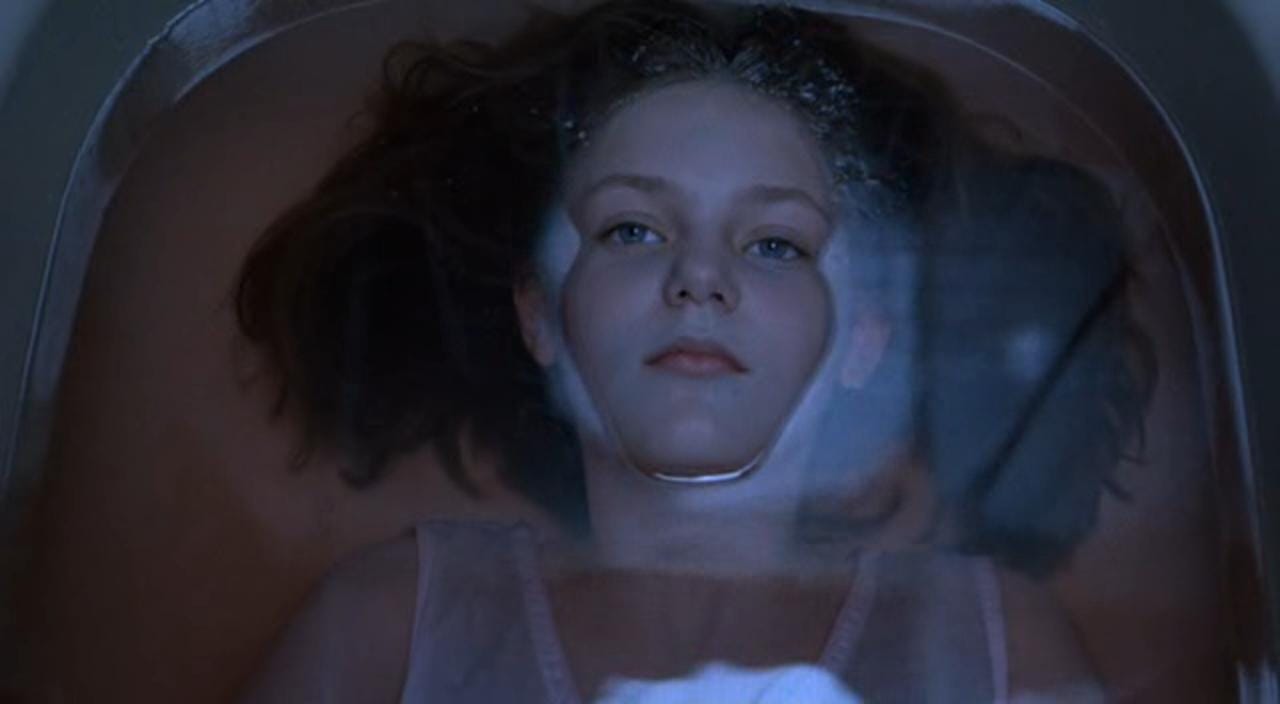
As female characters age, they are beset by feelings of ineptitude and depression. After puberty, they are no longer flying to Neverland or attending tea parties with mad hatters - they are attempting suicide and being institutionalised, like Esther in The Bell Jar, or they are selectively mute as a trauma response to being raped, like Melinda in Speak, or they are sticking their heads in ovens and hanging themselves and slashing their wrists like all of the Lisbon sisters in The Virgin Suicides. Once adults, these women are jumping in front of trains or swallowing arsenic or moulding away in the wedding dress they were jilted in decades prior, refusing to live a life outside of their own misery. As Leslie Jamison laments in Grand Unified Theory of Female Pain, detailing our widespread cultural obsession with female pain, and, further, the intersection between female beauty and female pain: “We see these wounded women everywhere.”
Even Eve begins her own story nude, free of cloth and rules and stigma and wounds. She too is eventually condemned to know knowledge, fabric, childbirth, and shame.
Womanhood - or girlhood, whatever you prefer to call it - is so often shaped by the visual. One could easily argue, or lament, that so much of being a woman is to be looked at. To be a spectacle viewed. To be constantly accompanied by the receptacles of being looked at - mirrors, both compact and full-length, and camera lenses, both our own and those directed by others - and the receptacles of looking “better” - lipstick, mascara, blush, hairbrushes, hairspray, weight loss program brochures, keto meal replacement shakes, facial cleansers, moisturising creams…I could go on, but then I wouldn’t know when to stop.
I would like to consider the evolution of the visuals of girlhood and womanhood. Girls have always posed, have always learnt how to be good at doing so, though the mediums have shifted throughout the years. But in any art gallery there are always girls, blushing and wet-eyed, in oil and acrylic and watercolour and ink, and we are always caught in the act of looking at them.
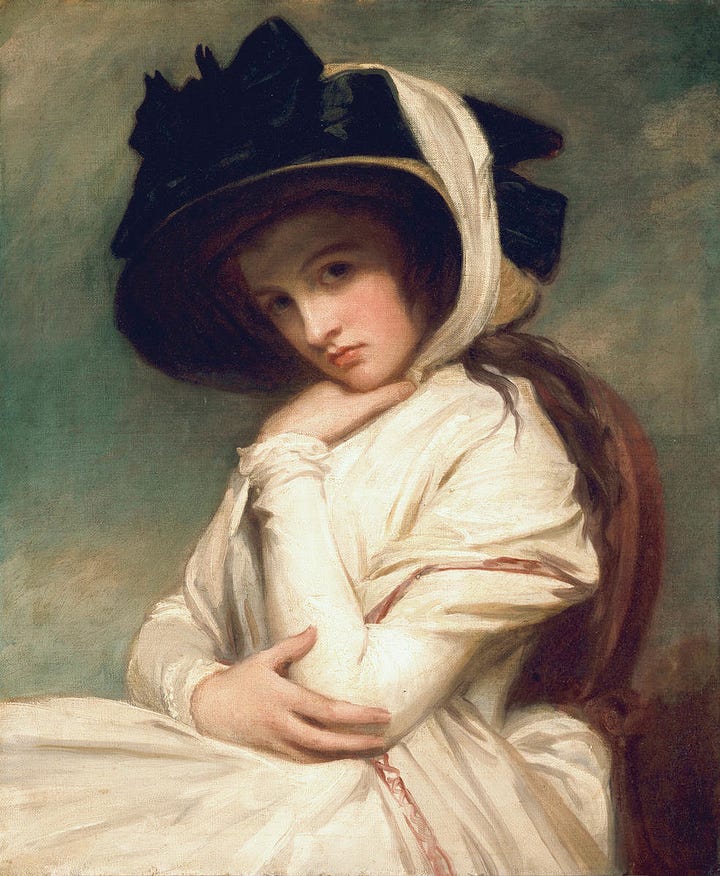
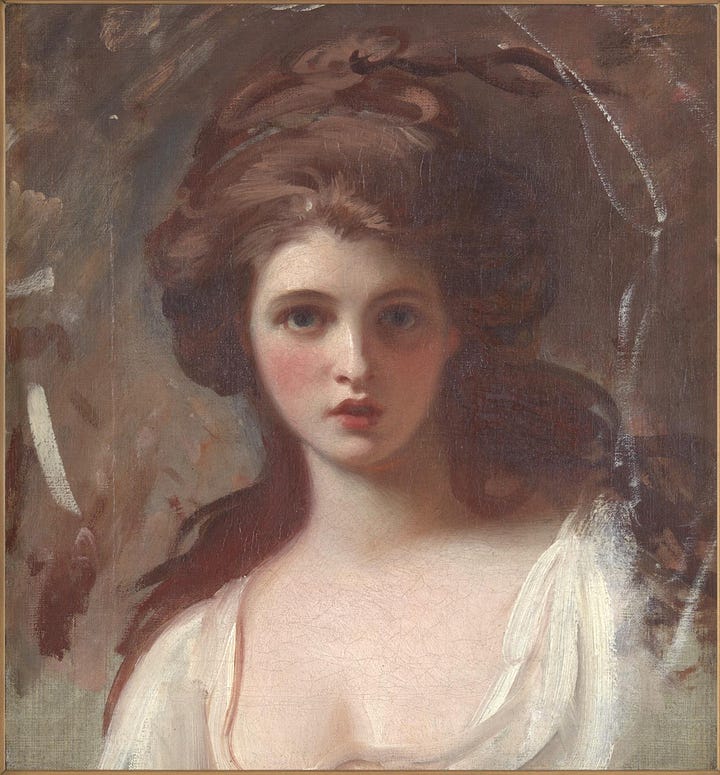
In Girlhood, Claire Marie Healy examines two portraits of Emma Hart, infamous mistress of naval hero Lord Nelson, painted by George Romney: Emma Hart, later Lady Hamilton, in a Straw Hat and Emma Hart as Circe. In both paintings, as we look at her, she stares defiantly back. Healy writes that “Hart is described ‘as’ something else: in each, she plays a role given to her by another.” She posits that Romney’s paintings of Emma Hart “tell us something about how girlhood always feels like a period of acting-something-out.” Always a spectacle viewed.
And we love to see a woman submerged - literally and metaphorically. Think of the staying impact of Sir John Everett Millais’s Ophelia (or the staying impact of Ophelia’s story in general). How many have since artistically recreated a similar scene? Girls on the verge of drowning are so becoming. The girls themselves know this. (When I was eighteen, just after I had moved out of home and was enjoying a certain level of fresh independence, I filled up a bathtub with cartons of expired milk, wore a wreath of plastic roses, and staged my own self-directed photoshoot. I ended up deleting all of the pictures - I hated them all.) And they are trained into self-exhibitionism from an early age, especially in the modern day. Self-exhibitionism in many ways is what online womanhood is. As Healy writes, “Self-portraits today amount to a social-requirement for girls.” And we are all aware of how to sell our own images. We are well aware of exactly what sells.
Sex sells, and so does pain.
Wounds are also an opening - just another thing to penetrate.
Girl, Interrupted was, interestingly enough, named after a painting: Johannes Vermeer’s Girl Interrupted at Her Music, painted between 1658 and 1659. In the painting, a young, bonneted girl grips her sheet music while her teacher stands behind her, bearing down on her. She looks away from him, her lips parted as if about to say something. She looks at us, well aware, it seems, that her image is being rendered in paint. People she will never know in centuries she will never see will continue to watch her as she is interrupted.
It has been part of the Frick Collection in New York since 1901.
Kaysen describes seeing the painting when she was seventeen and recoiling from it, sure that the girl trapped in the canvas was trying to warn her of something.
Sixteen years later, she returns to the Frick with a wealthy, judgemental boyfriend. “Oh,” she says, upon seeing Girl Interrupted at Her Music framed on a wall before her. “There’s a painting I love.” The boyfriend doesn’t understand what she sees in it.
“She had changed a lot in sixteen years,” Kaysen writes of the girl in the painting. “She was no longer urgent. In fact, she was sad. She was young and distracted, and her teacher was bearing down on her, trying to get her to pay attention. But she was looking out, looking for someone who would see her.”
Susanna cries, and her boyfriend tells her that she is selfish, that she is incapable of understanding art beyond its trivial relation to her own problems and identity. But still she is focused on the girl in the painting. She feels the need to tell her something.
“I see you,” Susanna says, floored by the painting’s overcast light.
I know all of these girls who flaunt and hide behind the visuals of their own sadness just want to be seen too. But I hope they learn to paint themselves with colours that are easier on the skin.
I was twenty-one when I went to New York with the plane ticket I bought mere days after being diagnosed with borderline personality disorder, and I forgot to go to the Frick. But I saw many paintings in my two weeks there. I stared at many girls who stared back at me. I saw Christina, approaching that faraway barn on her hands and knees. I saw all of Degas’s little rat girls twirling in tulle. I saw a woman in a gold-patterned robe, pregnant with colour and pregnant with child. I saw Frida with a fresh haircut, scissors in hand. And I saw the colour blue, for what felt like the very first time.1
Referenced Texts
The Second Sex by Simone de Beauvoir
The Deadliest Infectious Disease of All Time | Crash Course Lecture
Girlhood by Claire Marie Healy
Grand Unified Theory of Female Pain by Leslie Jamison
Girl, Interrupted by Susanna Kaysen
Girl, Interrupted dir. James Mangold
Illness as Metaphor by Susan Sontag
Pure Heroines by Jia Tolentino
this essay is an excerpt from a book i’m currently working on: a blend of memoir, essay, and cultural criticism about borderline personality disorder and the treatment of mental illness in women. if you want to support me as i attempt to Finish This Book and also Survive in this World, consider upgrading to paid or maybe even commission some work from me? i will write anything! peace and love <3







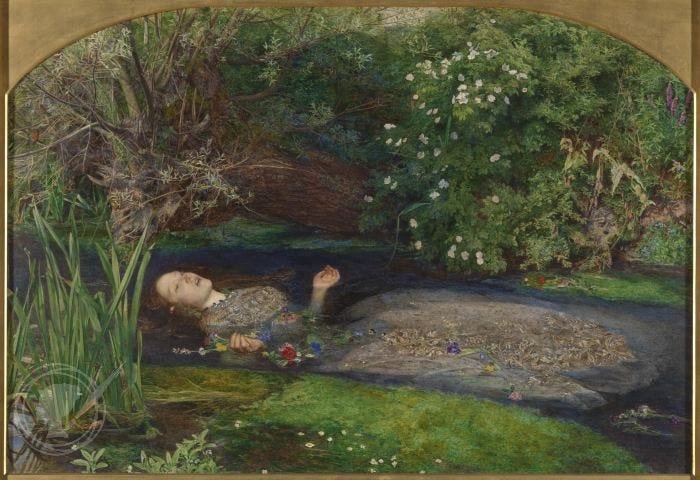
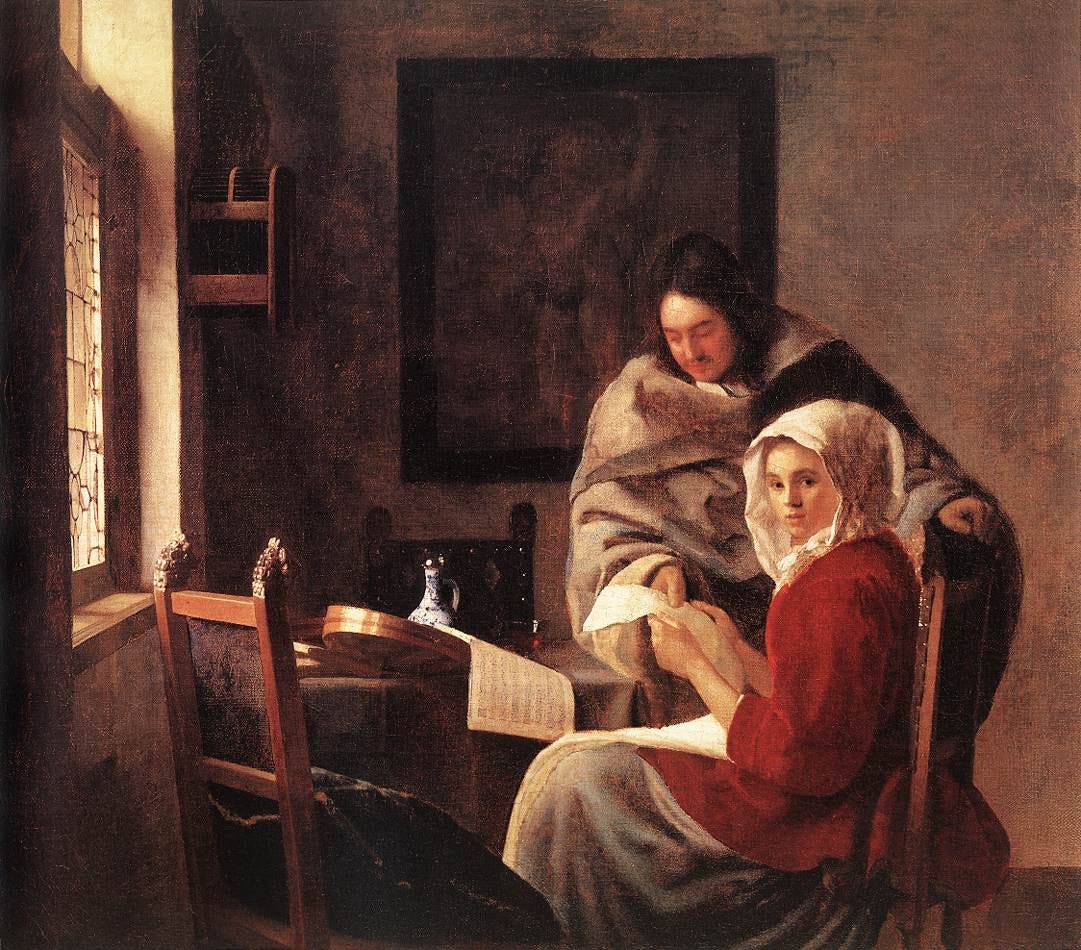

A great piece! Intelligence and insight.